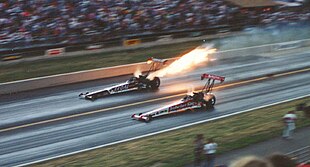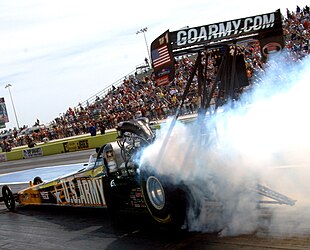
Back Versnelren Afrikaans Драг (автомобилен спорт) Bulgarian Cursa d'acceleració Catalan Dragster Czech Beschleunigungsrennen German Dragster Greek Carreras de aceleración (automovilismo) Spanish Drag racing Estonian Azelerazio-lasterketa (automobilismoa) Basque درگ (اتومبیلرانی) Persian
This article needs additional citations for verification. (June 2023) |

Drag racing is a type of motor racing in which automobiles or motorcycles compete, usually two at a time, to be first to cross a set finish line. The race follows a short, straight course from a standing start over a measured distance, most commonly 1⁄4 mi (1,320 ft; 402 m), with a shorter, 1,000 ft (0.19 mi; 304.80 m) distance becoming increasingly popular, as it has become the standard for Top Fuel dragsters and Funny Cars, where some major bracket races and other sanctioning bodies have adopted it as the standard. The 1⁄8 mi (660 ft; 201 m) is also popular in some circles. Electronic timing and speed sensing systems have been used to record race results since the 1960s.
The history of automobiles and motorcycles being used for drag racing is nearly as long as the history of motorized vehicles themselves, and has taken the form of both illegal street racing and as a regulated motorsport.

